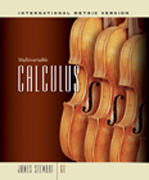
James Stewart's CALCULUS texts are widely renowned for their mathematical precision and accuracy, clarity of exposition, and outstanding examples and problem sets. Millions of students worldwide have explored calculus through Stewart's trademark style, while instructors have turned to his approach time and time again. In the Sixth Edition of CALCULUS, Stewart continues to set the standard for the course while adding new diagnostic tools, carefully revised content, and all-new course management tools built on the foundation of Stewart's renowned content. The patient explanations, superb exercises, focus on problem solving, and carefully graded problem sets that have made Stewart's texts best-sellers continue to provide a strong foundation for the Sixth Edition. From themost unprepared student to the most mathematically gifted, Stewart's writing and presentation serve to enhance understanding and build confidence. FeaturesStewart?s writing style speaks clearly and directly to the student, guiding them through key ideas, theorems, and problem solving steps. He encourages students to think as they read and learn calculus. Every concept is supported by thoughtfully worked examples--many with step-by-step explanations--and carefully chosen exercises. The quality of this pedagogical system is what sets Stewart?s texts above others. Examples are not only models for problem solving or a means of demonstrating techniques--they also encourage students to develop an analytic view of the subject. Many of these detailed examples display solutions that are presented graphically, analytically, and/or numerically to provide further insight into mathematical concepts. Margin notes expand on and clarifythe steps of the solution. The text?s clean, user-friendly design provides a clear presentation of calculus. The art program and its functional and consistent use of color helps students identify and review mathematical concepts moreeasily. The topic of Differential Equations is unified by the theme of modeling. Qualitative, numerical, and analytic approaches are given equal consideration. Stewart draws on physics, engineering, chemistry, biology, medicine, and social science to motivate students and demonstrate the power of calculus as aproblem-solving tool. Stewart?s presentation repeatedly provides answers to the question, ?When will I use this?? You?ll find many examples of how calculusis used as a problem-solving tool in fields such as physics, engineering, chemistry, biology, medicine, and the social sciences. Stewart?s text offers an extensive collection of more than 8,000 quality exercises. Each exercise set iscarefully graded, progressing from skill-development problems to more challenging problems involving applications and proofs. The wide variety of types of exercises includes many technology-oriented, thought-provoking, real, and engaging problems. Conceptual exercises encourage the development of communicationskills by explicitly requesting descriptions, conjectures, and explanations. These exercises stimulate critical thinking and reinforce the concepts of calculus. A wealth of engaging projects reinforce concepts. ?Writing Projects? askstudents to compare present-day methods with those of the founders of calculus. ?Discovery Projects? anticipate results to be discussed later. ?Applied Projects? feature content that engages student interest and demonstrates the real-world use of mathematics. ?Laboratory Projects? anticipate results to be discussed later or encourage discovery through pattern recognition. Comprehensive review sections follow each chapter. A ?Concept Check? and ?True/False Quiz? allow the student to prepare for upcoming tests through ideas and skill-building. These are included to further support conceptual understanding. "Strategies" sections (based on George Polya?s problem-solving methodology) help studentsselect what techniques they?ll need to solve problems in situations where thechoice is not obvious. These sections also help them develop true problem-solving skills and intuition. "Problems Plus" are collections of more challengingexercises, found at the end of every chapter. These exercises reinforce concepts by requiring students to apply techniques from more than one chapter of the text. "Problems Plus" sections patiently show students how to approach a challenging problem. Historical and biographical margin notes enliven the course and show students that mathematics was developed to help explain and representnatural phenomena.
- ISBN: 978-0-495-38363-5
- Editorial: Brooks-Cole
- Encuadernacion: Cartoné
- Páginas: 592
- Fecha Publicación: 01/01/2009
- Nº Volúmenes: 1
- Idioma: Inglés
- Inicio /
- MATEMÁTICAS /
- CÁLCULO
